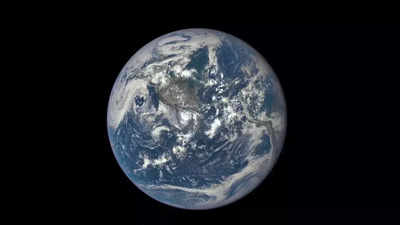- News
- Science News
- How Nasa managed to reestablish contact with most distant spacecraft from Earth
How Nasa managed to reestablish contact with most distant spacecraft from Earth
Nasa's Voyager 1 overcomes communication glitch, reconnects with Earth. Successful code relocation ensures continued operation. Mission team's innovative fix paves way for future data collection, reflecting on Voyager's remarkable journey since 1977.

File photo
NEW DELHI: After five months of silence, Nasa's Voyager 1 spacecraft is back in touch with Earth, having overcome a perplexing communication glitch through an innovative fix. The probe, which is currently 15 billion miles away from Earth, experienced issues with its flight data system's telemetry modulation unit in November 2023, resulting in indecipherable data transmissions.
The communication problem was marked by a repeating pattern of indecipherable code being sent back to Earth, rendering the data from the spacecraft's science instruments and engineering systems unusable.However, on April 20, Nasa engineers successfully received coherent data indicating that Voyager 1 is in good health and functioning correctly.
Linda Spilker, the Voyager project scientist at the Jet Propulsion Laboratory (JPL), expressed relief and anticipation for the future, saying, "Today was a great day for Voyager 1. We’re back in communication with the spacecraft. And we look forward to getting science data back."
The resolution came after the mission team employed a method of trial and error, leading to the discovery that a single chip in the flight data system’s memory was not functioning correctly. The chip's failure, possibly due to wear and tear or damage from a high-energy particle, led to 3% of the system’s memory being corrupted.
By April 18, the necessary commands were sent to Voyager 1 to reassign the code. Two days later, the team confirmed the success of their efforts when they received a response from the spacecraft. This success marks another milestone for Voyager 1, which, along with its twin Voyager 2, has been exploring space since 1977, far exceeding its original five-year mission plan.
As engineers continue to work on relocating other affected parts of the system’s software, they remain optimistic about the continued operation of the spacecraft. Suzanne Dodd, Voyager Project Manager, reflected on the ongoing journey, "We never know for sure what’s going to happen with the Voyagers, but it constantly amazes me when they just keep going. We’ve had many anomalies, and they are getting harder. But we’ve been fortunate so far to recover from them. And the mission keeps going. And younger engineers are coming onto the Voyager team and contributing their knowledge to keep the mission going."
The communication problem was marked by a repeating pattern of indecipherable code being sent back to Earth, rendering the data from the spacecraft's science instruments and engineering systems unusable.However, on April 20, Nasa engineers successfully received coherent data indicating that Voyager 1 is in good health and functioning correctly.
Linda Spilker, the Voyager project scientist at the Jet Propulsion Laboratory (JPL), expressed relief and anticipation for the future, saying, "Today was a great day for Voyager 1. We’re back in communication with the spacecraft. And we look forward to getting science data back."
The resolution came after the mission team employed a method of trial and error, leading to the discovery that a single chip in the flight data system’s memory was not functioning correctly. The chip's failure, possibly due to wear and tear or damage from a high-energy particle, led to 3% of the system’s memory being corrupted.
Unable to repair the chip directly, engineers developed a workaround by relocating the affected code to other parts of the system’s memory. This intricate process required adjusting the code to ensure that the entire system could continue to function cohesively.
By April 18, the necessary commands were sent to Voyager 1 to reassign the code. Two days later, the team confirmed the success of their efforts when they received a response from the spacecraft. This success marks another milestone for Voyager 1, which, along with its twin Voyager 2, has been exploring space since 1977, far exceeding its original five-year mission plan.
As engineers continue to work on relocating other affected parts of the system’s software, they remain optimistic about the continued operation of the spacecraft. Suzanne Dodd, Voyager Project Manager, reflected on the ongoing journey, "We never know for sure what’s going to happen with the Voyagers, but it constantly amazes me when they just keep going. We’ve had many anomalies, and they are getting harder. But we’ve been fortunate so far to recover from them. And the mission keeps going. And younger engineers are coming onto the Voyager team and contributing their knowledge to keep the mission going."
End of Article
FOLLOW US ON SOCIAL MEDIA

